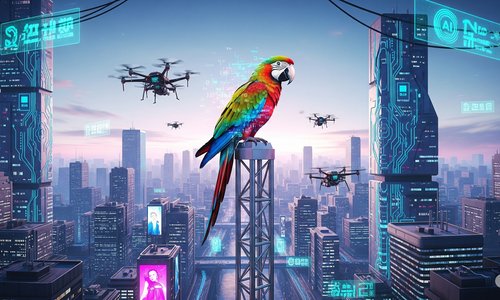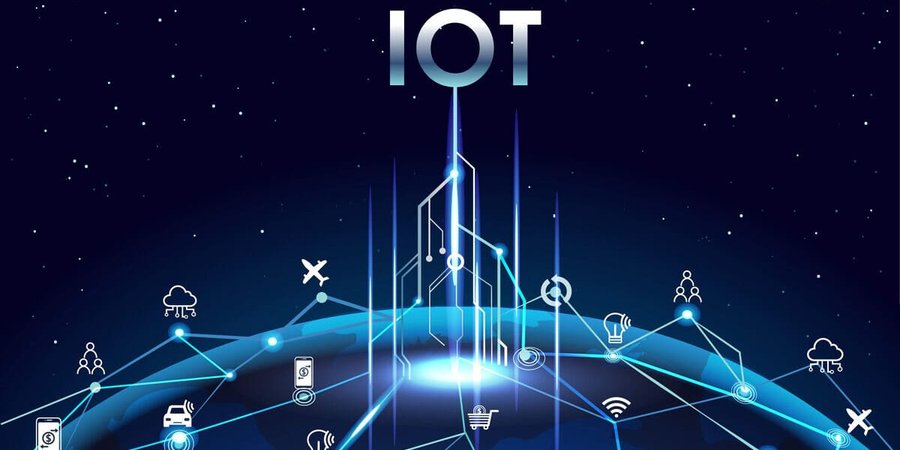
A Promessa e o Perigo da Nova Revolução Digital
A nova corrida tecnológica global levanta uma pergunta urgente: estamos prontos para confiar na inteligência que criamos?

Conectividade em ambiente de IoT
A AIoT, Inteligência Artificial das Coisas é a combinação das tecnologias de inteligência artificial com a infraestrutura da internet das coisas para obter operações de IoT mais eficientes, interações homem máquina melhoradas e gerenciamento e análise de dados aprimorados.
A IoT se baseia em dados captados por sensores, analisados em edge, fog ou cloud computing, respectivamente local, distribuída ou em nuvem, conectados com rede internet, virtual ou privada ativa de acordo com a latência determinada pela aplicação.
Os dispositivos inteligentes monitoram, armazenam, comunicam e, em alguns casos, se adaptam automaticamente aos dados, executando ações. Podem ser encontrados em linhas de produção, equipamentos financeiros, carros, eletroeletrônicos, dispositivos digitais, dispositivos comerciais, agronegócio, saúde, residências, cidades, prédios, governo, controle ambiental, sistemas logísticos e inúmeras áreas frequentadas por consumidores.
O ambiente de IoT tem seu fascínio, desde a “coisa” analisada, que é um sistema operativo que, com sensores integrados, gera quantidade massiva de dados; a “borda”, que é o lugar de processamento, fora dos datacenters e nuvens, próximos das “coisas”; e a conectividade, que é a comunicação para o alcance de rede com o usuário. As variedades ocorrem de acordo com a especificidades do ambiente.
A arquitetura IOT pode ser classificada em 3 camadas: a primeira é a do dispositivo sensor/atuador, a segunda é a da interconexão/conectividade e a terceira é a da aplicação/broker, acessada pelo usuário.
A conectividade, tema deste artigo introdutório, traz diversas informações: mobilidade, tecnologia de conexão, endereçamento, padronização de protocolos e um universo amplo de parâmetros de rede para melhor determinar o menor tempo possível e a melhor qualidade entre a “coisa” e o seu destino de conexão.
Cada solução que utiliza IoT possui seu próprio conjunto de requisitos de rede. Ter o conhecimento básico destes requisitos ajuda no entendimento do ambiente de implantação, determinando o projeto de conectividade mais apropriado.
Um projeto inteligente de IoT usualmente tem em sua estrutura as seguintes informações levantadas para contextualização: (1) escopo e uso; (2) missão crítica e confiabilidade; (3) segurança: autenticação, confidencialidade, criptografia; (4) tipo de rede, se pública ou privada; (5) capacidade da rede; (6) alcance, velocidade e intervalo; (7) cobertura do local da implementação; (8) possibilidade de uso de múltiplas tecnologias; (9) poder e modelo de processamento de dados, se local, distribuído ou em nuvem; (10) otimização de energia e baterias e (11) orçamento de serviços e infraestrutura disponíveis.
Cada solução que utiliza IoT possui seu próprio conjunto de requisitos de rede para conectividade. São as principais:
Rede é um conjunto de entidades interligadas uns aos outros. Esta interligação permite a escalabilidade e a agregação de valor da informação. Quão maior o número de entidades, maior o valor da rede. São encontrados nela: servidores clientes, suporte de conexão, dados e dispositivos compartilhados. A internet das coisas solicita dispositivos conectados. Elas podem utilizar frequências licenciadas ou não, podendo promover prévia autorização ao órgão regulador, Anatel. Espera-se, com a evolução de rede, a geração de um ecossistema massivo para a IoT.
Banda larga é a internet de alta velocidade, com disponibilidade ininterrupta. É a conectividade significativa, com velocidade de acordo com as requisições de serviço, isto é dito pois a banda larga de ontem muito provavelmente não será a banda larga de amanhã, ela precisa estar em constante evolução para suportar a qualidade de transmissão de conteúdo desejada. Quão mais larga a banda, mais informação pode ser transmitida. São alguns exemplos de banda larga: xDSLs, cable modem, redes móveis, radio, fibra ótica, wi-fi, internet via satélite. O aumento da velocidade de conexão permite consumo de serviços mais complexos com menos dificuldade.
Latência é o tempo de resposta de conexão de rede. Mede o tempo de transmissão de dados de um ponto a outro. É fator essencial para aplicações que exijam tempo real. É possível identificar a latência avaliando: a propagação, o throughput, o delay, o jitter, o loss, o router e o ping. A diminuição do tempo de resposta de conexão oferece interação em tempo real para os serviços.
Alcance é o quão longe um sinal consegue se propagar sem bloqueios. Determina a abrangência. É um dos principais fatores de custo de infraestrutura de rede. Determina a quantidade de pontos de rede e de repetição. Quão maior a frequência, menor o alcance, mais pontos de rede e repetição são necessários. As verticais de negócios de IoT solicitam redes locais e de longa distância, LAN e WAN, com configurações de redes virtuais para alinhar custos de rede às necessidades das aplicações.
Consumo de energia otimizado é fundamental para dispositivos de baixa potência no modo ativo, mas também nos modos de suspensão e fases de inicialização e desligamento. Depende do comportamento operacional da aplicação, da interação com a rede. Maior autonomia de bateria é solicitada na maior parte dos dispositivos, aplicações, operadoras de rede e provedores de serviços de IoT.
Segurança trata a proteção das vulnerabilidades dos elementos de rede e dispositivos contra os ataques cibernéticos. Proteção à ransomware, worms, DDoS (Distributed Denial of Service) e outros. Fundamental para a garantia do funcionamento do ecossistema IoT e evitar paralisação de operações por indisponibilidade.
A evolução das redes celulares tem acompanhado as soluções de IoT. Tem sido pontos de atenção: o alto custo dos planos de internet, o alto consumo de bateria e lacunas de cobertura em locais subterrâneos e remotos. O 5G traz a promessa de mais dispositivos conectados, maior velocidade, menor latência, segurança, economia na bateria e outros mais.
A IoT necessita de um endereço IP por dispositivo. O IPv6 vem para aumentar a capacidade de endereçamento e assim fomentar a conectividade de mais coisas na internet.
É essencial buscar a conectividade oportuna e adaptada para cada necessidade:
E é neste universo que o comitê de AIoT da I2AI se debruça em seus estudos, encontros e discussões, trazendo experiências do dia a dia profissional e acadêmico do grupo, de colegas convidados, da literatura e indústria AIoT, com o objetivo de gerar conteúdos de fácil compreensão para o grupo e público interessado da sociedade brasileira.
Glossário
Denise Nobre é membro do comitê de AIoT Robotics da I2AI. Engenheira de telecomunicações pela UFF- Universidade Federal Fluminense, com MBA em Gestão de Negócios pelo IBMEC-RJ, certificada como DA Senior Scrum Master pelo PMI – Project Management Institute, especializada em gestão de portfólios de projetos de tecnologia da informação e engenharia de telecomunicações, finalizando TCC em pós-graduação de Novas Tecnologias, Transformação Digital e Agilidade pela FIA-SP. Trabalhou por 20 anos com liderança e formação de equipes em gerenciamento de projetos, programas e portfólios de produtos e serviços móveis, fixos e satelitais.
Denise Nobre é membro do comitê de AIoT Robotics da I2AI. Engenheira de telecomunicações pela UFF - Universidade Federal Fluminense, com MBA em Gestão de Negócios pelo IBMEC-RJ, certificada como DA Senior Scrum Master pelo PMI – Project Management Institute, especializada em gestão de portfólios de projetos de tecnologia da informação e engenharia de telecomunicações, finalizando TCC em pós-graduação de Novas Tecnologias, Transformação Digital e Agilidade pela FIA-SP. Trabalhou por 20 anos com liderança e formação de equipes em gerenciamento de projetos, programas e portfólios de produtos e serviços móveis, fixos e satelitais.

A nova corrida tecnológica global levanta uma pergunta urgente: estamos prontos para confiar na inteligência que criamos?

Por que dominar a IA será a nova alfabetização do século XXI

Conselhos de Administração devem evoluir da supervisão reativa para a antecipação estratégica, frente à crescente complexidade e volatilidade dos ambientes de negócios.

De 14 a 25 de julho, reserve suas manhãs das 08h00 às 09h30 para participar da tradicional Maratona I2AI! Uma jornada intensa com debates e palestras sobre temas essenciais: Ética,